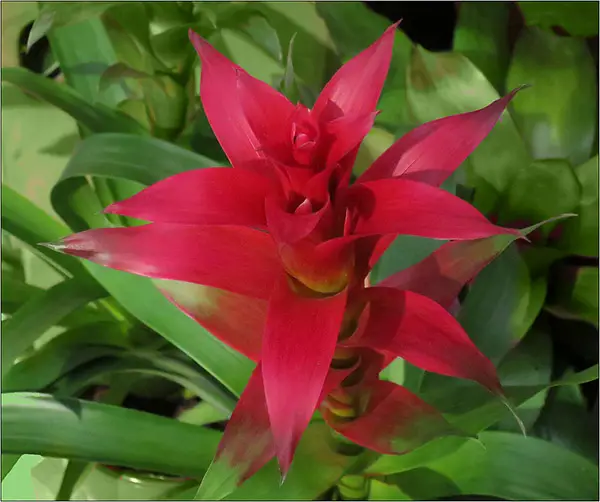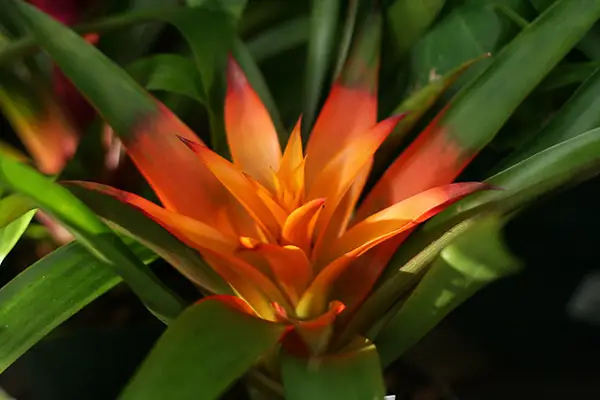Bromeliads are the plants of the Bromeliaceae family that consists of nearly 3500 known species, but when we talk about Bromeliad care, we mainly think of the ornamental varieties that make wonderful showy houseplants or outdoor plants in warm, frost-free regions. Take a look at this useful guide on taking care of bromeliads.

What is a Bromeliad Plant?
The most distinctive characteristic of a Bromeliad plant is its epiphytic way of life. An epiphyte is a plant that grows on another plant, but they differ from parasites as they use other plant’s surface only as a support. Bromeliads use their root system to attach to another plant, meaning they don’t get their nutrients from the soil. They get their moisture and nutrients from the air or rain. This feature makes them similar to orchids, so if you know how to care for orchids, bromeliad plant care will be a piece of cake for you.
Bromeliads are native to tropical regions of America, but some species are found in subtropical America and just one species is found in Africa. They are so diverse, but some similarities can be found. The foliage usually grows in a rosette, but the leaves vary from needle-thin to broad and flat, from spiky to soft, etc. They appear in a wide range of colors, from green to maroon, while variegated species can have red, gold, yellow, white, purple or cream variations.
Bromeliad’s most renowned feature is its colorful, showy bract, often mistaken for a flower. Bromeliads’ flowers grow out of the bracts in a wide range of shapes, sizes, and colors. Sadly, most of Bromeliads will bloom only once in a lifetime.
They are pet-friendly houseplants, non-toxic and completely safe to cats and dogs.
How to Take Care of Bromeliads
As being said, bromeliads are native to tropical regions and adapted to humid, warm, wet weather conditions and shady spots. So, if you live in a climate where temperatures never get below freezing, you can grow them outdoors, in a nice, shady place. In areas with dry air, moist them regularly to provide them with their daily dose of moisture and nutrients.
Bromeliad care indoors doesn’t differ much from outdoor bromeliad care. They are actually easy-care plants.
Potting Medium for Bromeliads
Bromeliads need excellent drainage in order to survive. You can fill a pot with a soilless mixture that allows good drainage – orchid bark, perlite, or some other organic material. If you still decide to use soil, you can use the same potting mix for Bromeliads as for cacti, succulents, and orchids. There’s no need for Bromeliad fertilizing, but if you think that your Bromeliad plant lacks nutrients, use a fertilizer for orchids.
Bromeliad Watering Tips
The main difference to other plants is that bromeliads don’t get their water through their root system. You can choose to ‘water’ them using the center cup filled with water, and this way they will take the moisture through the air. If you choose to water the soil, just soak it quickly and be sure that the excess water has leaked down. However, they are more adapted to tolerate drought comparing to overwatering, so be cautious when watering a Bromeliad.
They don’t tolerate hard water, so water them with rainwater or distilled water.
Some varieties have a tank as a central part of a plant. You can water these Bromeliad plants through the tank, but don’t let the water sit for too long.
If your Bromeliad plant isn’t potted – if it grows on a rock or a firm material, your only option is to sprinkle the leaves and moist it through the air.
Air Temperature and Humidity for Bromeliads
Since they need humid air to survive, mist them on a regular basis. You can even plant them in a room where other plants don’t do well and that’s a bathroom or a kitchen near the sink. If the air in your house is extremely dry, don’t give up on growing a Bromeliad. You can use a humidifier to keep the air humidity level consistent.
Bromeliads tolerate a wide range of temperatures, except the freezing ones.

Lighting Conditions
Bromeliads are mainly low-lights plants. Their natural habitat are shady places under huge leaves and tree canopies where just a tiny amount of sun rays can reach. Therefore, they don’t like lot of sun and they easily get sunburns when exposed to the direct sunlight. They can tolerate a bright place, but the direct sunlight is a big no.
Pots for Bromeliads
Bromeliads are surely full of surprises. Yet another interesting thing is that Bromeliads don’t like contact with metal, so don’t plant them in metal pots or containers. Use plastic pots, or better – unglazed clay pots that allow water to seep out thanks to their porosity.
Bromeliad Propagation
Many Bromeliad varieties die after flowering, but before they finish their life cycle, they’ve produced a bunch of babies. These pups appear at the base of a mother plant. Remove them carefully when their root is strong enough to bear the transplantation. Starting a Bromeliad plant from a seed is possible, but extremely slow, so we recommend this propagation method only to patient ones.
Common Problems with Bromeliads
Aside from environmental problems that appear due to inadequate care like too much water, exposure to the direct sun or poor drainage, Bromeliads rarely experience disease-related problems.
Although they have few pest problems, they are susceptible to mealy bug, aphids, and scale, and this kind of infestations Bromeliads can get when placed near an infected houseplant. In this case, apply neem oil or organic insecticidal soap to the plant.
Speaking of common Bromeliad problems, there’s one thing that usually freaks out a Bromeliad’s owner. When bract’s color starts to mute or fade out, or the entire bract goes brown, it’s commonly mistaken for some kind of a problem. This change is a sign that the plant is done blooming, which means the end of Bromeliad’s life cycle.